Nutrition and Digestion Assignment: Nutritional Needs and Processes
VerifiedAdded on 2023/01/19
|10
|1967
|56
Homework Assignment
AI Summary
This assignment delves into the multifaceted realm of nutrition and digestion, providing a comprehensive overview of essential dietary components and their roles in maintaining overall health. It begins by dissecting the components of a balanced diet, including carbohydrates, fats, proteins, minerals, and vitamins, emphasizing their individual contributions to energy production, growth, and bodily functions. The assignment then focuses on the specific nutritional needs of children aged 0-5 years, highlighting the importance of tailored dietary plans to support their growth and development. Furthermore, it explores methods for identifying various molecules in food, such as glucose, proteins, starch, and lipids, using tests like Benedict's, Biuret, and Sudan tests. It also provides an analysis of an appropriate food sample for a ketogenic diet. The assignment concludes by examining the functional adaptations of the alimentary canal, including the roles of teeth, tongue, epiglottis, stomach, and intestines, and elucidates the principles of ingestion, digestion, absorption, assimilation, and egestion. The assignment is supported by multiple references to provide credibility and support the information provided.
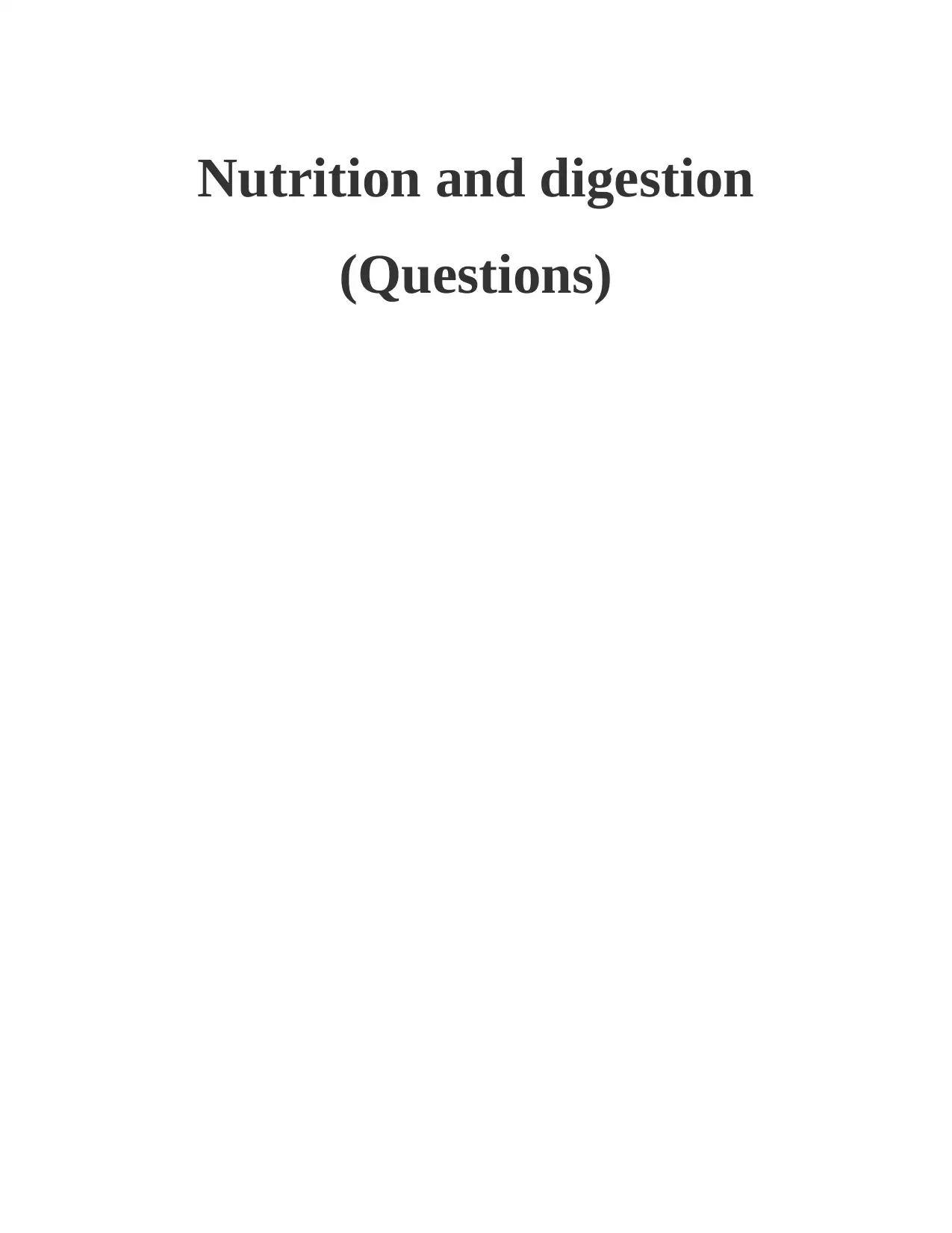
Nutrition and digestion
(Questions)
(Questions)
Paraphrase This Document
Need a fresh take? Get an instant paraphrase of this document with our AI Paraphraser
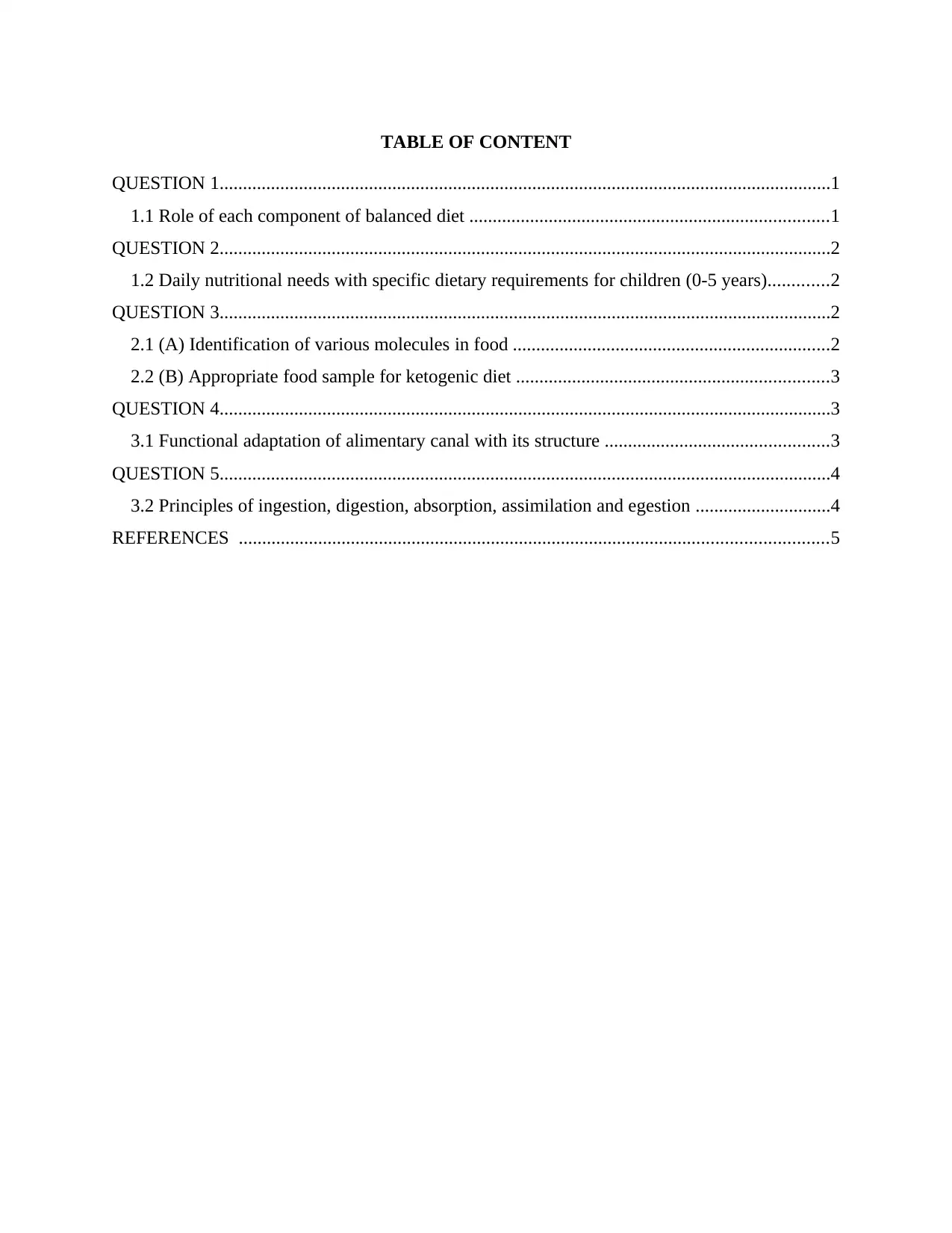
TABLE OF CONTENT
QUESTION 1...................................................................................................................................1
1.1 Role of each component of balanced diet .............................................................................1
QUESTION 2...................................................................................................................................2
1.2 Daily nutritional needs with specific dietary requirements for children (0-5 years).............2
QUESTION 3...................................................................................................................................2
2.1 (A) Identification of various molecules in food ....................................................................2
2.2 (B) Appropriate food sample for ketogenic diet ...................................................................3
QUESTION 4...................................................................................................................................3
3.1 Functional adaptation of alimentary canal with its structure ................................................3
QUESTION 5...................................................................................................................................4
3.2 Principles of ingestion, digestion, absorption, assimilation and egestion .............................4
REFERENCES ..............................................................................................................................5
QUESTION 1...................................................................................................................................1
1.1 Role of each component of balanced diet .............................................................................1
QUESTION 2...................................................................................................................................2
1.2 Daily nutritional needs with specific dietary requirements for children (0-5 years).............2
QUESTION 3...................................................................................................................................2
2.1 (A) Identification of various molecules in food ....................................................................2
2.2 (B) Appropriate food sample for ketogenic diet ...................................................................3
QUESTION 4...................................................................................................................................3
3.1 Functional adaptation of alimentary canal with its structure ................................................3
QUESTION 5...................................................................................................................................4
3.2 Principles of ingestion, digestion, absorption, assimilation and egestion .............................4
REFERENCES ..............................................................................................................................5
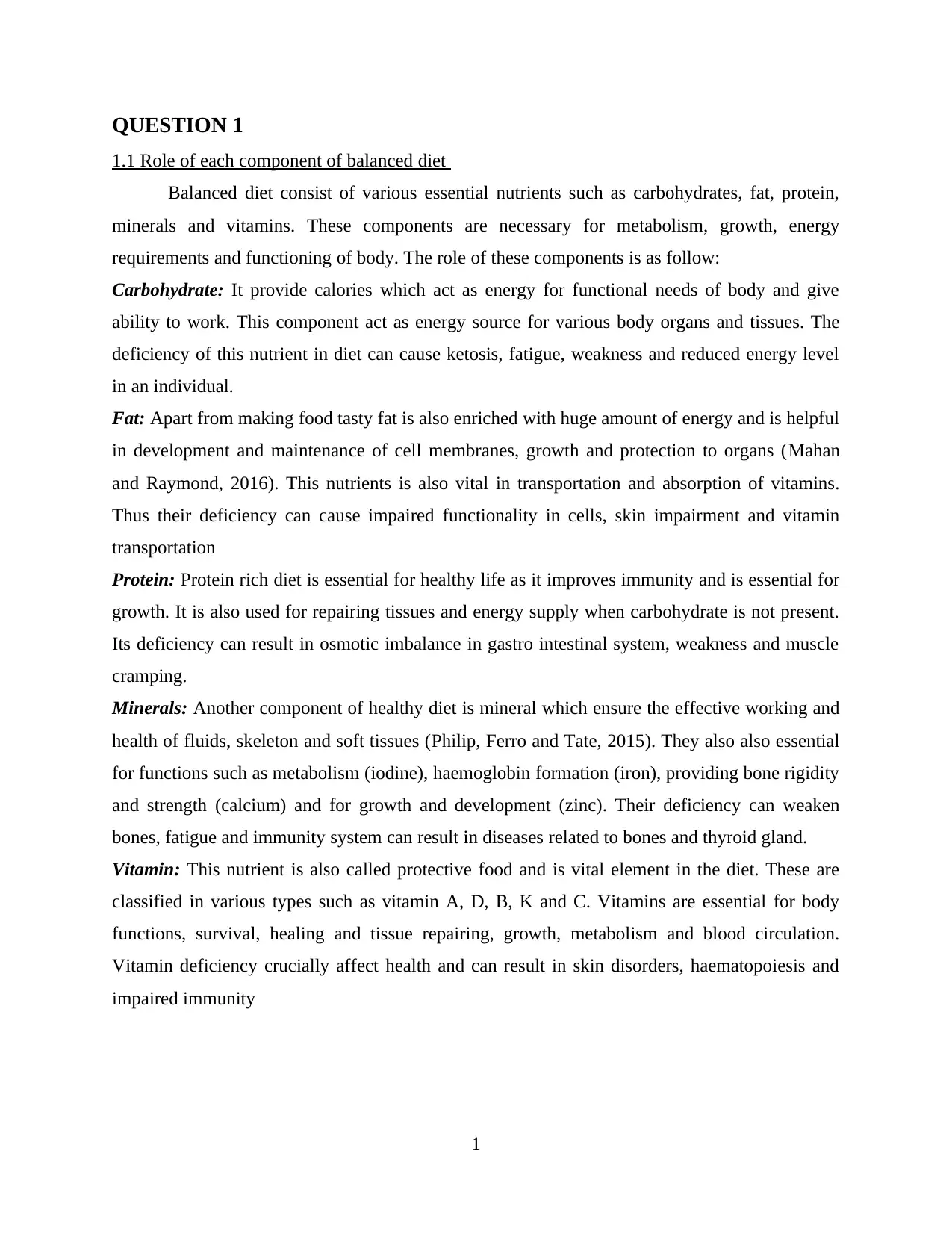
QUESTION 1
1.1 Role of each component of balanced diet
Balanced diet consist of various essential nutrients such as carbohydrates, fat, protein,
minerals and vitamins. These components are necessary for metabolism, growth, energy
requirements and functioning of body. The role of these components is as follow:
Carbohydrate: It provide calories which act as energy for functional needs of body and give
ability to work. This component act as energy source for various body organs and tissues. The
deficiency of this nutrient in diet can cause ketosis, fatigue, weakness and reduced energy level
in an individual.
Fat: Apart from making food tasty fat is also enriched with huge amount of energy and is helpful
in development and maintenance of cell membranes, growth and protection to organs (Mahan
and Raymond, 2016). This nutrients is also vital in transportation and absorption of vitamins.
Thus their deficiency can cause impaired functionality in cells, skin impairment and vitamin
transportation
Protein: Protein rich diet is essential for healthy life as it improves immunity and is essential for
growth. It is also used for repairing tissues and energy supply when carbohydrate is not present.
Its deficiency can result in osmotic imbalance in gastro intestinal system, weakness and muscle
cramping.
Minerals: Another component of healthy diet is mineral which ensure the effective working and
health of fluids, skeleton and soft tissues (Philip, Ferro and Tate, 2015). They also also essential
for functions such as metabolism (iodine), haemoglobin formation (iron), providing bone rigidity
and strength (calcium) and for growth and development (zinc). Their deficiency can weaken
bones, fatigue and immunity system can result in diseases related to bones and thyroid gland.
Vitamin: This nutrient is also called protective food and is vital element in the diet. These are
classified in various types such as vitamin A, D, B, K and C. Vitamins are essential for body
functions, survival, healing and tissue repairing, growth, metabolism and blood circulation.
Vitamin deficiency crucially affect health and can result in skin disorders, haematopoiesis and
impaired immunity
1
1.1 Role of each component of balanced diet
Balanced diet consist of various essential nutrients such as carbohydrates, fat, protein,
minerals and vitamins. These components are necessary for metabolism, growth, energy
requirements and functioning of body. The role of these components is as follow:
Carbohydrate: It provide calories which act as energy for functional needs of body and give
ability to work. This component act as energy source for various body organs and tissues. The
deficiency of this nutrient in diet can cause ketosis, fatigue, weakness and reduced energy level
in an individual.
Fat: Apart from making food tasty fat is also enriched with huge amount of energy and is helpful
in development and maintenance of cell membranes, growth and protection to organs (Mahan
and Raymond, 2016). This nutrients is also vital in transportation and absorption of vitamins.
Thus their deficiency can cause impaired functionality in cells, skin impairment and vitamin
transportation
Protein: Protein rich diet is essential for healthy life as it improves immunity and is essential for
growth. It is also used for repairing tissues and energy supply when carbohydrate is not present.
Its deficiency can result in osmotic imbalance in gastro intestinal system, weakness and muscle
cramping.
Minerals: Another component of healthy diet is mineral which ensure the effective working and
health of fluids, skeleton and soft tissues (Philip, Ferro and Tate, 2015). They also also essential
for functions such as metabolism (iodine), haemoglobin formation (iron), providing bone rigidity
and strength (calcium) and for growth and development (zinc). Their deficiency can weaken
bones, fatigue and immunity system can result in diseases related to bones and thyroid gland.
Vitamin: This nutrient is also called protective food and is vital element in the diet. These are
classified in various types such as vitamin A, D, B, K and C. Vitamins are essential for body
functions, survival, healing and tissue repairing, growth, metabolism and blood circulation.
Vitamin deficiency crucially affect health and can result in skin disorders, haematopoiesis and
impaired immunity
1
⊘ This is a preview!⊘
Do you want full access?
Subscribe today to unlock all pages.

Trusted by 1+ million students worldwide
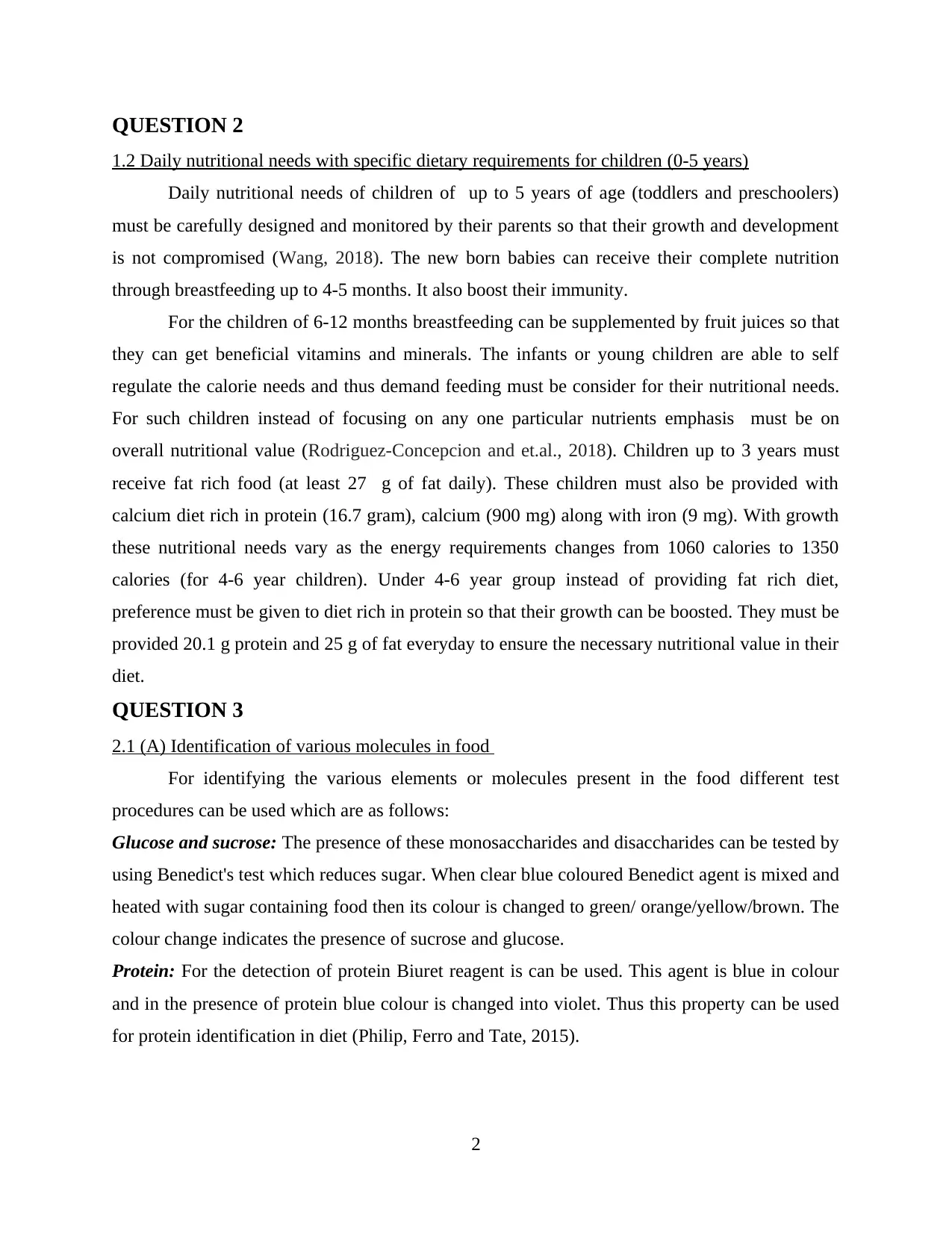
QUESTION 2
1.2 Daily nutritional needs with specific dietary requirements for children (0-5 years)
Daily nutritional needs of children of up to 5 years of age (toddlers and preschoolers)
must be carefully designed and monitored by their parents so that their growth and development
is not compromised (Wang, 2018). The new born babies can receive their complete nutrition
through breastfeeding up to 4-5 months. It also boost their immunity.
For the children of 6-12 months breastfeeding can be supplemented by fruit juices so that
they can get beneficial vitamins and minerals. The infants or young children are able to self
regulate the calorie needs and thus demand feeding must be consider for their nutritional needs.
For such children instead of focusing on any one particular nutrients emphasis must be on
overall nutritional value (Rodriguez-Concepcion and et.al., 2018). Children up to 3 years must
receive fat rich food (at least 27 g of fat daily). These children must also be provided with
calcium diet rich in protein (16.7 gram), calcium (900 mg) along with iron (9 mg). With growth
these nutritional needs vary as the energy requirements changes from 1060 calories to 1350
calories (for 4-6 year children). Under 4-6 year group instead of providing fat rich diet,
preference must be given to diet rich in protein so that their growth can be boosted. They must be
provided 20.1 g protein and 25 g of fat everyday to ensure the necessary nutritional value in their
diet.
QUESTION 3
2.1 (A) Identification of various molecules in food
For identifying the various elements or molecules present in the food different test
procedures can be used which are as follows:
Glucose and sucrose: The presence of these monosaccharides and disaccharides can be tested by
using Benedict's test which reduces sugar. When clear blue coloured Benedict agent is mixed and
heated with sugar containing food then its colour is changed to green/ orange/yellow/brown. The
colour change indicates the presence of sucrose and glucose.
Protein: For the detection of protein Biuret reagent is can be used. This agent is blue in colour
and in the presence of protein blue colour is changed into violet. Thus this property can be used
for protein identification in diet (Philip, Ferro and Tate, 2015).
2
1.2 Daily nutritional needs with specific dietary requirements for children (0-5 years)
Daily nutritional needs of children of up to 5 years of age (toddlers and preschoolers)
must be carefully designed and monitored by their parents so that their growth and development
is not compromised (Wang, 2018). The new born babies can receive their complete nutrition
through breastfeeding up to 4-5 months. It also boost their immunity.
For the children of 6-12 months breastfeeding can be supplemented by fruit juices so that
they can get beneficial vitamins and minerals. The infants or young children are able to self
regulate the calorie needs and thus demand feeding must be consider for their nutritional needs.
For such children instead of focusing on any one particular nutrients emphasis must be on
overall nutritional value (Rodriguez-Concepcion and et.al., 2018). Children up to 3 years must
receive fat rich food (at least 27 g of fat daily). These children must also be provided with
calcium diet rich in protein (16.7 gram), calcium (900 mg) along with iron (9 mg). With growth
these nutritional needs vary as the energy requirements changes from 1060 calories to 1350
calories (for 4-6 year children). Under 4-6 year group instead of providing fat rich diet,
preference must be given to diet rich in protein so that their growth can be boosted. They must be
provided 20.1 g protein and 25 g of fat everyday to ensure the necessary nutritional value in their
diet.
QUESTION 3
2.1 (A) Identification of various molecules in food
For identifying the various elements or molecules present in the food different test
procedures can be used which are as follows:
Glucose and sucrose: The presence of these monosaccharides and disaccharides can be tested by
using Benedict's test which reduces sugar. When clear blue coloured Benedict agent is mixed and
heated with sugar containing food then its colour is changed to green/ orange/yellow/brown. The
colour change indicates the presence of sucrose and glucose.
Protein: For the detection of protein Biuret reagent is can be used. This agent is blue in colour
and in the presence of protein blue colour is changed into violet. Thus this property can be used
for protein identification in diet (Philip, Ferro and Tate, 2015).
2
Paraphrase This Document
Need a fresh take? Get an instant paraphrase of this document with our AI Paraphraser
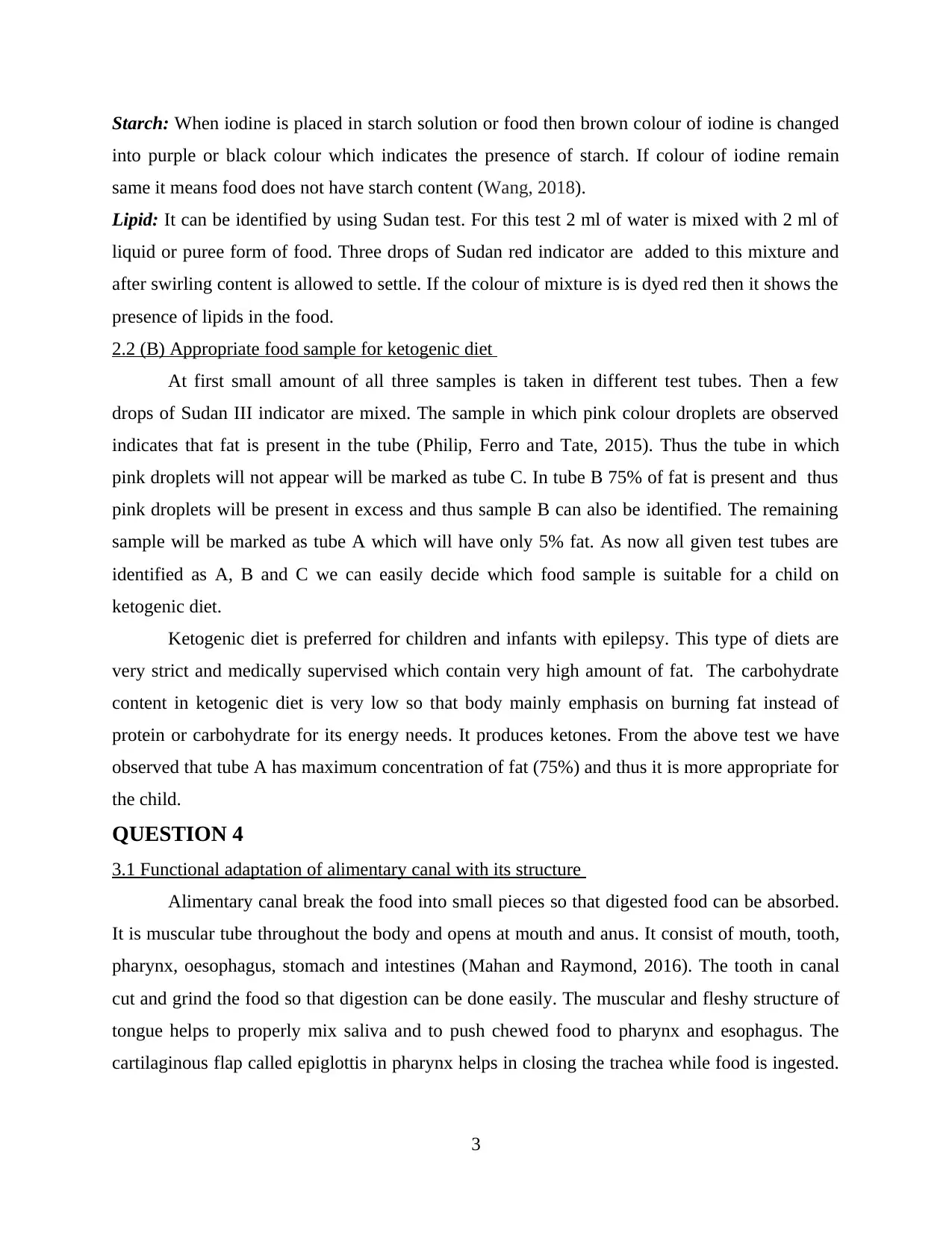
Starch: When iodine is placed in starch solution or food then brown colour of iodine is changed
into purple or black colour which indicates the presence of starch. If colour of iodine remain
same it means food does not have starch content (Wang, 2018).
Lipid: It can be identified by using Sudan test. For this test 2 ml of water is mixed with 2 ml of
liquid or puree form of food. Three drops of Sudan red indicator are added to this mixture and
after swirling content is allowed to settle. If the colour of mixture is is dyed red then it shows the
presence of lipids in the food.
2.2 (B) Appropriate food sample for ketogenic diet
At first small amount of all three samples is taken in different test tubes. Then a few
drops of Sudan III indicator are mixed. The sample in which pink colour droplets are observed
indicates that fat is present in the tube (Philip, Ferro and Tate, 2015). Thus the tube in which
pink droplets will not appear will be marked as tube C. In tube B 75% of fat is present and thus
pink droplets will be present in excess and thus sample B can also be identified. The remaining
sample will be marked as tube A which will have only 5% fat. As now all given test tubes are
identified as A, B and C we can easily decide which food sample is suitable for a child on
ketogenic diet.
Ketogenic diet is preferred for children and infants with epilepsy. This type of diets are
very strict and medically supervised which contain very high amount of fat. The carbohydrate
content in ketogenic diet is very low so that body mainly emphasis on burning fat instead of
protein or carbohydrate for its energy needs. It produces ketones. From the above test we have
observed that tube A has maximum concentration of fat (75%) and thus it is more appropriate for
the child.
QUESTION 4
3.1 Functional adaptation of alimentary canal with its structure
Alimentary canal break the food into small pieces so that digested food can be absorbed.
It is muscular tube throughout the body and opens at mouth and anus. It consist of mouth, tooth,
pharynx, oesophagus, stomach and intestines (Mahan and Raymond, 2016). The tooth in canal
cut and grind the food so that digestion can be done easily. The muscular and fleshy structure of
tongue helps to properly mix saliva and to push chewed food to pharynx and esophagus. The
cartilaginous flap called epiglottis in pharynx helps in closing the trachea while food is ingested.
3
into purple or black colour which indicates the presence of starch. If colour of iodine remain
same it means food does not have starch content (Wang, 2018).
Lipid: It can be identified by using Sudan test. For this test 2 ml of water is mixed with 2 ml of
liquid or puree form of food. Three drops of Sudan red indicator are added to this mixture and
after swirling content is allowed to settle. If the colour of mixture is is dyed red then it shows the
presence of lipids in the food.
2.2 (B) Appropriate food sample for ketogenic diet
At first small amount of all three samples is taken in different test tubes. Then a few
drops of Sudan III indicator are mixed. The sample in which pink colour droplets are observed
indicates that fat is present in the tube (Philip, Ferro and Tate, 2015). Thus the tube in which
pink droplets will not appear will be marked as tube C. In tube B 75% of fat is present and thus
pink droplets will be present in excess and thus sample B can also be identified. The remaining
sample will be marked as tube A which will have only 5% fat. As now all given test tubes are
identified as A, B and C we can easily decide which food sample is suitable for a child on
ketogenic diet.
Ketogenic diet is preferred for children and infants with epilepsy. This type of diets are
very strict and medically supervised which contain very high amount of fat. The carbohydrate
content in ketogenic diet is very low so that body mainly emphasis on burning fat instead of
protein or carbohydrate for its energy needs. It produces ketones. From the above test we have
observed that tube A has maximum concentration of fat (75%) and thus it is more appropriate for
the child.
QUESTION 4
3.1 Functional adaptation of alimentary canal with its structure
Alimentary canal break the food into small pieces so that digested food can be absorbed.
It is muscular tube throughout the body and opens at mouth and anus. It consist of mouth, tooth,
pharynx, oesophagus, stomach and intestines (Mahan and Raymond, 2016). The tooth in canal
cut and grind the food so that digestion can be done easily. The muscular and fleshy structure of
tongue helps to properly mix saliva and to push chewed food to pharynx and esophagus. The
cartilaginous flap called epiglottis in pharynx helps in closing the trachea while food is ingested.
3
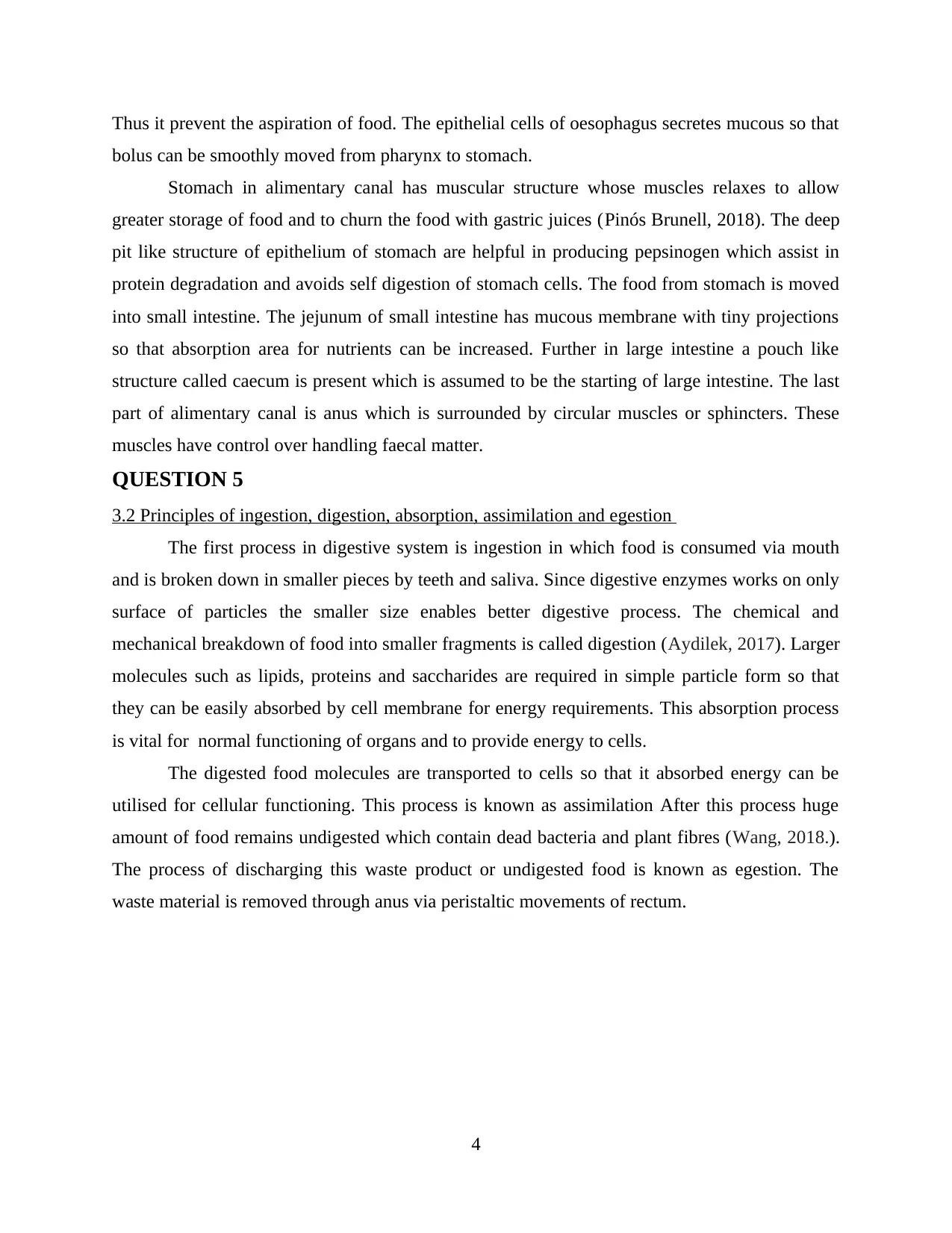
Thus it prevent the aspiration of food. The epithelial cells of oesophagus secretes mucous so that
bolus can be smoothly moved from pharynx to stomach.
Stomach in alimentary canal has muscular structure whose muscles relaxes to allow
greater storage of food and to churn the food with gastric juices (Pinós Brunell, 2018). The deep
pit like structure of epithelium of stomach are helpful in producing pepsinogen which assist in
protein degradation and avoids self digestion of stomach cells. The food from stomach is moved
into small intestine. The jejunum of small intestine has mucous membrane with tiny projections
so that absorption area for nutrients can be increased. Further in large intestine a pouch like
structure called caecum is present which is assumed to be the starting of large intestine. The last
part of alimentary canal is anus which is surrounded by circular muscles or sphincters. These
muscles have control over handling faecal matter.
QUESTION 5
3.2 Principles of ingestion, digestion, absorption, assimilation and egestion
The first process in digestive system is ingestion in which food is consumed via mouth
and is broken down in smaller pieces by teeth and saliva. Since digestive enzymes works on only
surface of particles the smaller size enables better digestive process. The chemical and
mechanical breakdown of food into smaller fragments is called digestion (Aydilek, 2017). Larger
molecules such as lipids, proteins and saccharides are required in simple particle form so that
they can be easily absorbed by cell membrane for energy requirements. This absorption process
is vital for normal functioning of organs and to provide energy to cells.
The digested food molecules are transported to cells so that it absorbed energy can be
utilised for cellular functioning. This process is known as assimilation After this process huge
amount of food remains undigested which contain dead bacteria and plant fibres (Wang, 2018.).
The process of discharging this waste product or undigested food is known as egestion. The
waste material is removed through anus via peristaltic movements of rectum.
4
bolus can be smoothly moved from pharynx to stomach.
Stomach in alimentary canal has muscular structure whose muscles relaxes to allow
greater storage of food and to churn the food with gastric juices (Pinós Brunell, 2018). The deep
pit like structure of epithelium of stomach are helpful in producing pepsinogen which assist in
protein degradation and avoids self digestion of stomach cells. The food from stomach is moved
into small intestine. The jejunum of small intestine has mucous membrane with tiny projections
so that absorption area for nutrients can be increased. Further in large intestine a pouch like
structure called caecum is present which is assumed to be the starting of large intestine. The last
part of alimentary canal is anus which is surrounded by circular muscles or sphincters. These
muscles have control over handling faecal matter.
QUESTION 5
3.2 Principles of ingestion, digestion, absorption, assimilation and egestion
The first process in digestive system is ingestion in which food is consumed via mouth
and is broken down in smaller pieces by teeth and saliva. Since digestive enzymes works on only
surface of particles the smaller size enables better digestive process. The chemical and
mechanical breakdown of food into smaller fragments is called digestion (Aydilek, 2017). Larger
molecules such as lipids, proteins and saccharides are required in simple particle form so that
they can be easily absorbed by cell membrane for energy requirements. This absorption process
is vital for normal functioning of organs and to provide energy to cells.
The digested food molecules are transported to cells so that it absorbed energy can be
utilised for cellular functioning. This process is known as assimilation After this process huge
amount of food remains undigested which contain dead bacteria and plant fibres (Wang, 2018.).
The process of discharging this waste product or undigested food is known as egestion. The
waste material is removed through anus via peristaltic movements of rectum.
4
⊘ This is a preview!⊘
Do you want full access?
Subscribe today to unlock all pages.

Trusted by 1+ million students worldwide
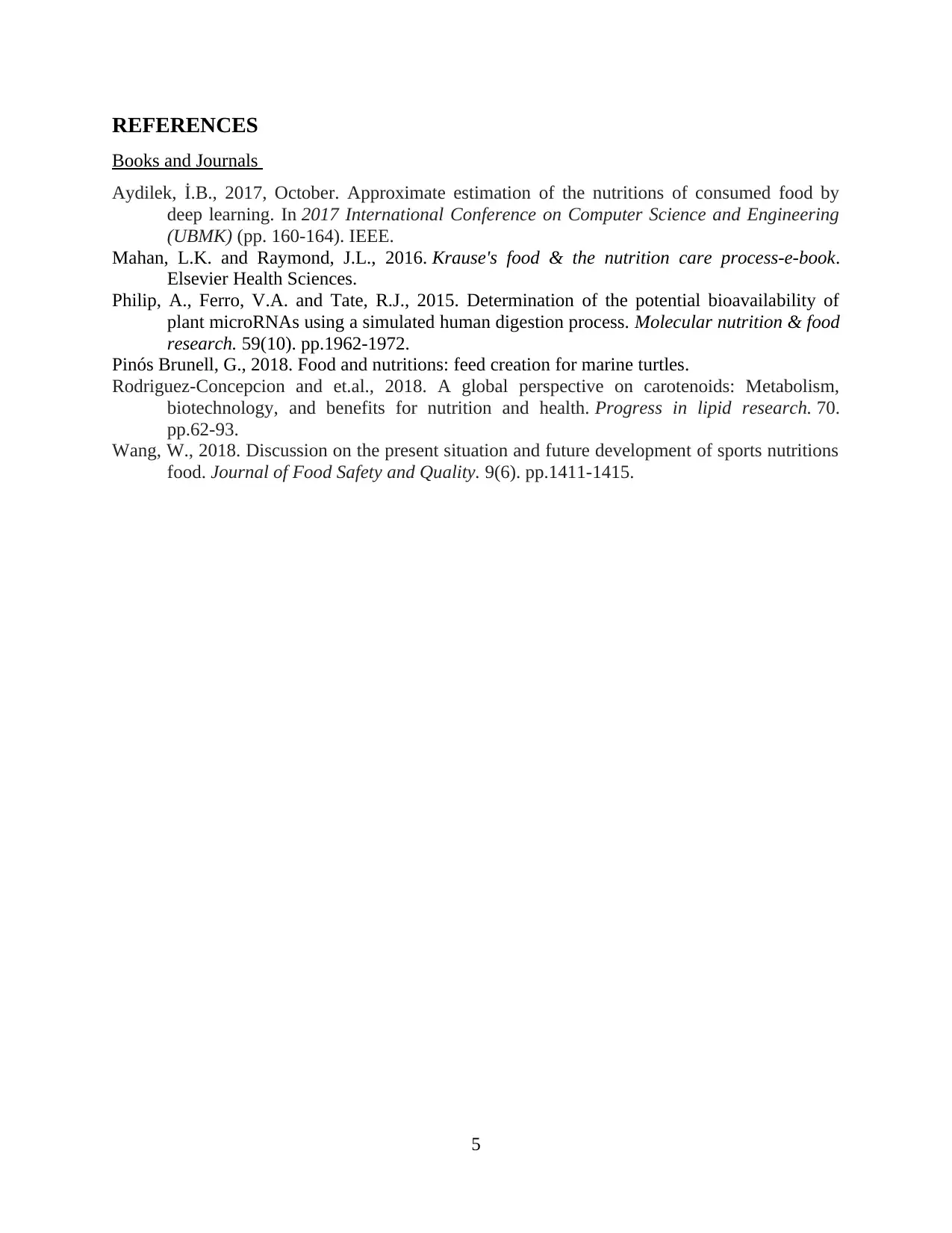
REFERENCES
Books and Journals
Aydilek, İ.B., 2017, October. Approximate estimation of the nutritions of consumed food by
deep learning. In 2017 International Conference on Computer Science and Engineering
(UBMK) (pp. 160-164). IEEE.
Mahan, L.K. and Raymond, J.L., 2016. Krause's food & the nutrition care process-e-book.
Elsevier Health Sciences.
Philip, A., Ferro, V.A. and Tate, R.J., 2015. Determination of the potential bioavailability of
plant microRNAs using a simulated human digestion process. Molecular nutrition & food
research. 59(10). pp.1962-1972.
Pinós Brunell, G., 2018. Food and nutritions: feed creation for marine turtles.
Rodriguez-Concepcion and et.al., 2018. A global perspective on carotenoids: Metabolism,
biotechnology, and benefits for nutrition and health. Progress in lipid research. 70.
pp.62-93.
Wang, W., 2018. Discussion on the present situation and future development of sports nutritions
food. Journal of Food Safety and Quality. 9(6). pp.1411-1415.
5
Books and Journals
Aydilek, İ.B., 2017, October. Approximate estimation of the nutritions of consumed food by
deep learning. In 2017 International Conference on Computer Science and Engineering
(UBMK) (pp. 160-164). IEEE.
Mahan, L.K. and Raymond, J.L., 2016. Krause's food & the nutrition care process-e-book.
Elsevier Health Sciences.
Philip, A., Ferro, V.A. and Tate, R.J., 2015. Determination of the potential bioavailability of
plant microRNAs using a simulated human digestion process. Molecular nutrition & food
research. 59(10). pp.1962-1972.
Pinós Brunell, G., 2018. Food and nutritions: feed creation for marine turtles.
Rodriguez-Concepcion and et.al., 2018. A global perspective on carotenoids: Metabolism,
biotechnology, and benefits for nutrition and health. Progress in lipid research. 70.
pp.62-93.
Wang, W., 2018. Discussion on the present situation and future development of sports nutritions
food. Journal of Food Safety and Quality. 9(6). pp.1411-1415.
5
Paraphrase This Document
Need a fresh take? Get an instant paraphrase of this document with our AI Paraphraser

6

7
⊘ This is a preview!⊘
Do you want full access?
Subscribe today to unlock all pages.

Trusted by 1+ million students worldwide

8
1 out of 10
Related Documents
Your All-in-One AI-Powered Toolkit for Academic Success.
+13062052269
info@desklib.com
Available 24*7 on WhatsApp / Email
![[object Object]](/_next/static/media/star-bottom.7253800d.svg)
Unlock your academic potential
Copyright © 2020–2025 A2Z Services. All Rights Reserved. Developed and managed by ZUCOL.





